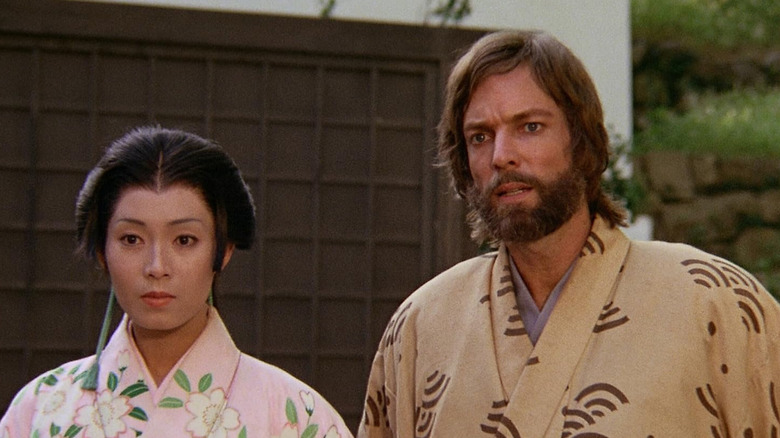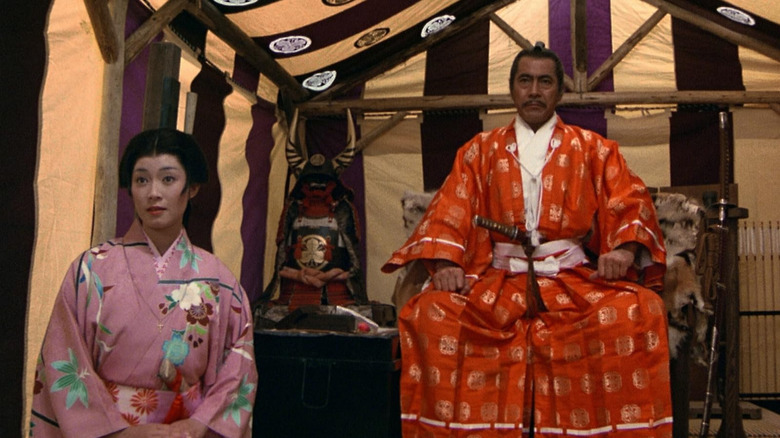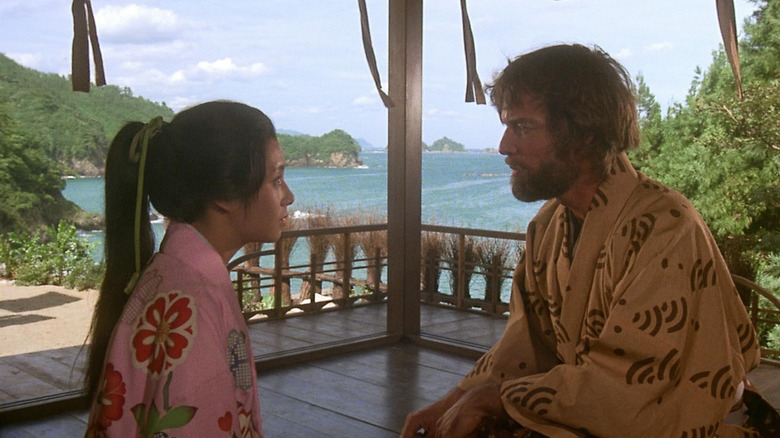The '80s Shogun Miniseries Is Hard To Watch Today
We may receive a commission on purchases made from links.
The recent FX miniseries "Shōgun," a 10-episode adaptation of James Clavell's epic 1975 novel of the same name, was a massive success. It earned strong enough ratings and reviews that FX renewed it for another two seasons, even though the source material was already fully covered. We don't know how the series can possibly maintain its quality with two of its best characters gone, but it'll at least be interesting to see the show try.
With all this talk about the 2024 show, it's easy to forget that "Shōgun" had already been adapted into a TV show over forty years earlier. That miniseries was only five episodes long (extended to six in subsequent media releases), and they were all released on NBC over the course of one week in September 1980. The miniseries wasn't well-received in Japan (more on that in a bit), but it was a massive ratings hit in the United States.
Despite being a major success, the 1980 "Shōgun" is surprisingly hard to get your hands on these days. It's not available for free on any streaming service, so you'll have to pay some money directly on sites like Amazon, YouTube, or Roku to watch it. (There's also a decent chance the DVD is available at your local library, so definitely check there first to see if you can spare yourself the twelve dollars.)
Why is the 1980 Shogun so hard to get your hands on?
It's not clear why the 1980 "Shōgun" is so tough to find streaming, but maybe part of it is due to the miniseries aging strangely. Especially in the aftermath of the excellent 2024 series, the original show has drawn flak for its portrayal of the series' Japanese characters. The 1980 version doesn't flesh out the Japanese characters to the same degree, nor does it offer subtitles for their dialogue.
It's easy to see the appeal of this approach several decades ago: Showrunner Eric Bercovici understood that such a massive novel was impossible to adapt in full, so he streamlined things by keeping the audience limited to Blackthorne's perspective. This helped to keep an American audience more connected to Blackthorne, as we felt his confusion and frustration with the language barrier right alongside with him. Blackthorne's frustration is an element that is pretty understated in the '24 series; we know Cosmo Jarvis' version of the character is struggling to understand the culture, but we don't feel that struggle as intensely.
It may have seemed like a reasonable creative choice for Bercovici to hold the Japanese characters at arm's length at the time, but the problem is that Toranaga and Mariko are easily two of the most interesting characters from the book, and it feels like a shame for the miniseries to not dive into their headspace to the same extent the book did. The approach also came off as disrespectful to Japanese viewers, many of whom were reportedly frustrated by the historical inaccuracies and the general lack of depth to the Japanese characters.
Why the 1980 Shogun is still worth a watch
The 1980 "Shōgun" showrunner Bercovici stirred up some controversy last year when he criticized the new show for not prioritizing its American audience. "It's very technical and very difficult for an American audience to get their grips into it," he said. "I've talked to many people that have watched it, and they said, 'I had to turn it off because I don't understand it.' So the filmmakers of the new one really didn't care about the American audience."
That's an odd critique for a couple reasons, with one being that American audiences clearly loved the new show despite whatever Bercovici's friends seem to think. Although many viewers of the TV show came in not knowing much about 1600s Japan, they respected a show that trusted their intelligence. When it came to the more shocking aspects of samurai culture, American viewers proved themselves willing to either learn more or to simply embrace that confusion. The 2024 series didn't need to dumb things down, because the audience was largely willing to meet them at their level.
The other issue is that "Shōgun" (2024) was clearly a show with international ambitions, one that wanted to do right by its Japanese viewers as well as its American ones. It let its Japanese characters be co-protagonists alongside Blackthorne, a decision that was not only truer to the book but which made for a more nuanced, compelling story. Bercovici appreciated this to some extent, noting that he was "happy" they went a different direction "because I didn't want my show to be copied."
But regardless of whatever Bercovici has said, the 1980 miniseries is still worth a shot simply for its glimpse into how the American TV landscape has evolved. People often complain that American TV has been dumbed down over the years, but the difference between the '80 and '24 series proves this isn't as straightforward a trend as you'd think. You can also see, with the two series, the effect of a growing Japanese presence in American culture. Part of why American audiences were so on board with a more Japan-centric "Shōgun" is because Japanese shows and movies are far more popular with modern Americans than they were in 1980.
"Shōgun" (1980) showed the sort of approach a Japanese period drama would need to take to be successful in the United States; "Shōgun" (2024) showed how American audiences' needs (or rather, the perception of their needs) has changed in the subsequent few decades.


